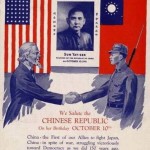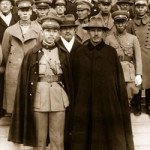
The Second United Front was a fragile alliance between the Chinese Communist Party (CCP) and Nationalist forces, between December 1936 and 1946. Following the Shanghai Massacre in April 1927 the CCP went into a state of retreat from Nationalist forces. They remained in conflict until the mid-1930s, when Japan began to threaten an invasion of China. In 1935 the Communist International (Comintern) in Moscow urged communist parties to form alliances with non-communist governments and groups, in order to combat fascism and militarism. In China, the CCP began calling for national unity against Japanese military aggression. Slogans circulated included “Chinese must not fight Chinese” and “Immediate war with Japan; stop fighting Communists”. They generated some nationalist sentiment and aided the communist cause. Jiang Jieshi, on the other hand, remained focused on eradicating the CCP, declaring that the “Japanese were a disease of the skin [while] communism is a disease of the heart”.
Despite criticism of his skewed priorities, Chiang maintained his campaign against the CCP. Confident he could finish off the communists in Shaanxi, Jiang ordered the northern warlord Zhang Xueliang, known as the ‘Young Marshall’, to mobilise his Northeastern Army for an anti-communist offensive. But Zhang was less concerned about the CCP than he was by Jiang’s inaction against foreign aggressors. Zhang had fought against the communists in southern China in the 1930s, but in 1936 he held secret talks with Zhou Enlai and other CCP figures, hoping to negotiate an alliance against an imminent Japanese invasion. Zhang had a score to settle, his warlord father having lost his Manchurian base to the Japanese. In addition, Zhang’s own soldiers came from the northern peasantry and were susceptible to CCP and anti-Japanese propaganda.
In December 1936 Jiang flew to Zhang Xueliang’s headquarters in Xi’an, Shaanxi province for talks. At this meeting, Zhang told Jiang he was not prepared to fight the communists while there was a threat from foreigners. Knowing that Jiang would probably punish his defiance, Zhang ordered 150 troops to storm Jiang’s quarters. The generalissimo, who was wearing pyjamas and doing his morning exercises, scrambled into the undergrowth behind the resort and hid in a cave. He surrendered to Zhang later that day. CCP leaders were naturally delighted with this news, the Politburo’s Standing Committee demanding the “elimination” of Jiang. Soviet leader Joseph Stalin did not agree, however, considering Jiang to be China’s best hope for resisting the Japanese. The influential communist leader Zhou Enlai was sent to Xi’an to negotiate on behalf of the CCP. After meeting with Jiang’s wife, Soong Meiling, as well as Jiang himself, Zhou negotiated a ceasefire between the CCP and the Nationalists. He also facilitated Jiang’s release. The agreement between Zhou, Zhang and Jiang included an acceptance of Sun Yixian’s Three Principles, while the Red Army was placed under a central command, becoming the Eight Route Army and New Fourth Route Army.
“Instead of rushing to seize Jiang’s power [after his kidnapping] soldiers and officials from all parts of the country began a bombardment of telegrams demanding the release, rescue or ransoming of Jiang Jieshi at any cost. It was the ultimate testimony that after centuries the Chinese people had at last found a leader. It is too early to give credence to rumours that Banker Soong was obliged to unsnarl the kidnapping with millions of dollars in bribes. The more popular, official version is that [Jiang’s kidnappers] and the Communists were “greatly touched” by the contents of the Generalissimo’s diary – which convinced them that he was not pro-Japanese at heart.”
TIME magazine, Jan. 1938
The CCP used the new United Front to its advantage. In the mid-1930s, the communist foothold in northern Shaanxi was very fragile. By representing their actions in 1936-37 as a commitment to the anti-Japanese resistance, the CCP won further support from the peasants. According to a retired party cadre from Yan’an, “without the Xi’an Incident, the revolution could not have survived to the War of Resistance [war with Japan].” In 1972 Mao told the Japanese prime minister Kakuei Tanaka he was grateful for the Japanese presence in China in the 1930s because by distracting and weakening the Nationalists, the Japanese had saved the communists from destruction. Many historians agree, like Joseph Esherwick, who says that “without the communists’ 1936 truce with the Northeast Army, and that army’s December kidnapping of Jiang Jieshi, the Guomingdang might have tightened the noose and eliminated the Red Army.”

While there was some military cooperation between the Red Army and the Nationalists, such as in the Battle of Taiyuan (late 1937) and Battle of Wuhan (1938), the communists generally operated independently. Red Army units avoided full-scale battles with the Japanese, preferring to engage in guerrilla warfare. In regions not under the control of or threat from the Japanese, the Nationalists and CCP continued their struggle for control. From Jiang Jieshi downward, the upper echelons of the Nationalist army still harboured bitter hatred of the communists. This often emerged in local skirmishes between the communists and Nationalists. The most notable of these was the New Fourth Army Incident. In January 1941 an 80,000-strong Nationalist regiment broke the Second United Front by attacking the headquarters of the CCP’s New Fourth Army. Of the 9,000 CCP soldiers inside, more than three quarters were killed, taken captive or went missing. The attack was costly for the CCP but it also allowed them to present themselves as “martyred patriots”. When foreign powers entered the war with Japan in 1942 they soon realised most of Jiang’s attention was given to planning and overseeing operations against the CCP, not the Japanese. After the Japanese surrender, American advisors like George Marshall were unable to broker a lasting peace agreement between Mao Zedong and Jiang Jieshi. By early 1946 the Guomindang and CCP were again in a state of war.

1. The outbreak of the Second Sino-Japanese War allowed the CCP to avoid annihilation by the GMD, consolidate their position in Shaanxi and build their support base.
2. Joseph Stalin advocated an anti-fascist alliance and persuaded the CCP to negotiate a truce with Jiang Jieshi.
3. In December 1936 Jiang was arrested by Zhang Xueliang, a commander of the Northeastern Army who objected to Jiang’s inadequate response to Japanese aggression. The Xi’an Incident, as it became known, forced Jiang to form the Second United Front.
4. The alliance was precarious and short-lived. When not engaged with the Japanese, the CCP and GMD continued fighting. This erupted into civil war following the Japanese surrender in 1945.
5. Most historians agree that the Second United Front was advantageous for the CCP. It gave the Yanan Soviet a reprieve from GMD attacks, aided the further development and growth of the Red Army and won the propaganda war for the communists. These factors left the CCP in a strong position at the start of the civil war.
© Alpha History 2018. Content on this page may not be republished or distributed without permission. For more information please refer to our Terms of Use.
This page was written by Rebecca Cairns. To reference this page, use the following citation:
R. Cairns, “The Second United Front”, Alpha History, accessed [today’s date], https://alphahistory.com/chineserevolution/second-united-front/.
This website uses pinyin romanisations of Chinese words and names. Please refer to this page for more information.
